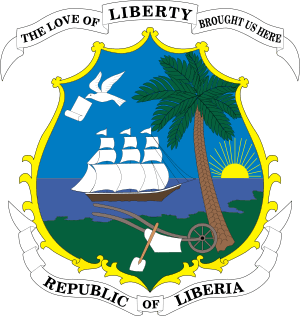Republic of Liberia national defence forces facts for kids
Quick facts for kids Republic of Liberia Defence Force |
|
|---|---|
| Current form | 1848 |
| Parts | Liberian army
Liberian air force Liberian navy |
| Headquarters | Monrovia |
| Leadership | |
| Commander-in-Chief | Ellen Johnson sirleaf |
| Serving soldiers | |
| Military age | 18 years for selection process, 17 years to serve, 18 years to deploy on operations (2013) |
| Active employees/soldiers | 189,000 |
| Reserve personnel | 51,232 (Active) |
| Deployed personnel | 2,241 (10 September 2015) |
| Expenditures | |
| Budget | 500 Million |
| Percent of GDP | 2.92 percen |
| Industry | |
| Suppliers from inland | South Africa |
| Suppliers from foreign countries |
United States of America |
| Annual imports | weapons, jets, tanks, medvac |
| Annual exports | $3,000,000 |
The Armed Forces of Liberia (AFL) is the official military of the country of Liberia. It helps keep the country safe and protects its people. The AFL includes the Liberian Army, Air Force, and Navy. Its main office is in Monrovia, the capital city.
The military has a long history, dating back to 1848. It plays an important role in Liberia's security.
Contents
What is Armed Forces Day?
Armed Forces Day is a special holiday in Liberia. It celebrates the brave men and women who serve in the country's military. Before 1955, there wasn't one single day to honor all military branches. Instead, different army and militia groups had their own parade days.
How Did Armed Forces Day Start?
In 1954, a military officer named Colonel Francis M. Dean suggested a new idea. He thought there should be one special day for all parts of the Liberian Armed Forces. He called it the "Old Soldier Army Festival." On this day, military units across the country would gather for parades and exercises.
Colonel Dean's idea was approved by President William V.S. Tubman. The President then sent the idea to the lawmakers to make it a law.
Why Was February 11 Chosen?
When lawmakers discussed Colonel Dean's idea, they wanted a meaningful date. They decided it should be a day linked to a heroic event in Liberian military history. This way, future generations of soldiers would remember the brave actions of those who came before them.
The event that came to mind was the Major Cadell incident from 1909.
The Major Cadell Incident
Major Mckay Cadell was a British officer who commanded the Liberian Frontier Force (LFF). In 1909, he caused trouble for the Liberian government. His actions were stopped by the first militia regiment. This group was led by Lieutenant Colonel Isaac Moart and Major Joseph Dennis.
Initially, lawmakers chose May 9 as Armed Forces Day. However, historians pointed out that the Major Cadell incident actually happened in February. After some discussion, the date was changed to February 9 in 1956.
But then, some people who were there during the incident said it was February 11, 1909. So, on January 26, 1957, the date was finally set as February 11. This is the day Liberia celebrates Armed Forces Day today.
Major Cadell had brought some soldiers from Sierra Leone with him. He encouraged them to act against the Liberian government because of unpaid salaries. The Liberian Frontier Force stopped their actions. Cadell and his soldiers were told to leave Liberia within 24 hours.
Where Was the Military Located?
The main military barracks, called "Camp Johnson," used to be where the Executive Mansion is now. The Executive Mansion is the official office of the President of Liberia.
Building a New Military
After a period of challenges, Liberia began to rebuild its military. This effort is part of a program called Security Sector Reform (SSR). The goal is to create a strong, disciplined, and law-abiding army.
DynCorp International, with support from the United States government, helped train this new army. The new Armed Forces of Liberia is designed to be about 2,000 strong.
The Armed Forces of Liberia celebrated its 100th anniversary in 2008. The celebration of Armed Forces Day in 2008 marked the 51st time the day was observed since 1957.


